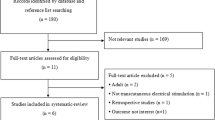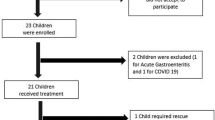Abstract
Slow-transit constipation (STC) is a newly described subtype of intractable constipation in children which we originally identified with deficiency of substance P in axons supplying the proximal colonic muscle. When nuclear transit studies became available, the patients were found to have slow proximal colonic transit, and responded to antegrade enemas. Using the appendicostomy, we found that there was reduced frequency in propagating sequences throughout the colon. We began testing whether transcutaneous electrical stimulation (TES) could improve motility and symptoms, and over several trials have now shown that TES is remarkably effective in treating children with STC, with long-lasting effects. TES holds promise for treating STC, as well as a range of gastrointestinal motility disorders.


Similar content being viewed by others
References
Hyams J et al (2002) Functional gastrointestinal disorders: Working Group Report of the First World Congress of Pediatric Gastroenterology, Hepatology, and Nutrition. J Pediatr Gastroenterol Nutr 35(Suppl 2):S110–S117
Nunez RM, Fabbro MA (2013) Contipation in children: diagnosis and treatment. In: Nunez RM, Fabbrom MA (eds) Public Health in the 21st Century. Nova Science Publishers, New York
Iacono G et al (1998) Intolerance of cow’s milk and chronic constipation in children. N Engl J Med 339(16):1100–1104
Benninga M et al (2005) The Paris Consensus on Childhood Constipation Terminology (PACCT) Group. J Pediatr Gastroenterol Nutr 40(3):273–275
Shin YM et al (2002) Signs and symptoms of slow-transit constipation versus functional retention. J Pediatr Surg 37(12):1762–1765
Dinning PG et al (2011) The impact of laxative use upon symptoms in patients with proven slow transit constipation. BMC Gastroenterol 11:121
Hutson J (1996) intractable constipation with a decrease in substance P immunoreactive fibres: is it a variant of intestinal neuronal dysplasia? J Pediatr Surg 31:580–583
Yik YI et al (2011) Gender differences in reduced substance P (SP) in children with slow-transit constipation. Pediatr Surg Int 27(7):699–704
Southwell BR et al (2010) Decrease in nerve fibre density in human sigmoid colon circular muscle occurs with growth but not aging. Neurogastroenterol Motil 22(4):439–445 (e106)
King SK et al (2010) Substance P and vasoactive intestinal peptide are reduced in right transverse colon in pediatric slow-transit constipation. Neurogastroenterol Motil 22(8):883–892 (e234)
Benninga M et al (1996) Colonic transit time in constipated children: does pediatric slow-transit constipation exist? J Pediatr Gastroenterol Nutr 23:241–251
Benninga M et al (1995) Defaecation disorders in children, colonic transit time versus the Barr-score. Eur J Pediatr 154:277–284
Hutson JM et al (2001) Slow transit constipation in children. J Paediatr Child Health 37(5):426–430
Wheatley JM et al (1999) Slow-transit constipation in childhood. J Pediatr Surg 34:829–833
Reilly DJ et al (2008) Connective tissue disorder–a new subgroup of boys with slow transit constipation? J Pediatr Surg 43(6):1111–1114
Treepongkaruna S et al (2001) Gastrointestinal transit and anorectal manometry in children with colonic substance P deficiency. J Gastroenterol Hepatol 16(6):624–630
Imaji R et al (2000) Rectal mucosal biopsy compared with laparoscopic seromuscular biopsy in the diagnosis of intestinal neuronal dysplasia in children with slow-transit constipation. J Pediatr Surg 35(12):1724–1727
Uemura S et al (1998) Distribution of substance P- and VIP-immunoreactive nerve fibres in the colonic circular muscle in children. Pediatr Surg Int 14:66–70
Cook BJ et al (2005) Radionuclear transit to assess sites of delay in large bowel transit in children with chronic idiopathic constipation. J Pediatr Surg 40(3):478–483
Marshall J et al (2001) Antegrade continence enemas in the treatment of slow-transit constipation. J Pediatr Surg 36:1227–1230
King SK et al (2005) The antegrade continence enema successfully treats idiopathic slow-transit constipation. J Pediatr Surg 40(12):1935–1940
Stanton MP, Shin YM, Hutson JM (2002) Laparoscopic placement of the Chait cecostomy device via appendicostomy. J Pediatr Surg 37(12):1766–1767
Malone PS, Ransley PG, Kiely EM (1990) Preliminary report: the antegrade continence enema. Lancet 336:1217–1218
Stanton MP et al (2005) Colonic manometry via appendicostomy shows reduced frequency, amplitude, and length of propagating sequences in children with slow-transit constipation. J Pediatr Surg 40(7):1138–1145
King SK et al (2008) 24-Hour colonic manometry in pediatric slow transit constipation shows significant reductions in antegrade propagation. Am J Gastroenterol 103(8):2083–2091
Dinning PG et al (2010) Pancolonic spatiotemporal mapping reveals regional deficiencies in, and disorganization of colonic propagating pressure waves in severe constipation. Neurogastroenterol Motil 22(12):e340–e349
Wiklendt L et al (2013) Classification of normal and abnormal colonic motility based on cross-correlations of pancolonic manometry data. Neurogastroenterol Motil 25(3):e215–e223
Sutcliffe JR et al (2004) Paediatric constipation for adult surgeons—article 1: targeting the cause. ANZ J Surg 74(9):777–780
Chase J et al (2005) Pilot study using transcutaneous electrical stimulation (interferential current) to treat chronic treatment-resistant constipation and soiling in children. J Gastroenterol Hepatol 20(7):1054–1061
van Wunnik BP, Baeten CG, Southwell BR (2011) Neuromodulation for constipation: Sacral and transcutaneous stimulation. Best Pract Res Clin Gastroenterol 25(1):181–191
Carrington EV et al (2014) A systematic review of sacral nerve stimulation mechanisms in the treatment of fecal incontinence and constipation. Neurogastroenterol Motil 26(9):1222–1237
Kajbafzadeh AM et al (2009) Effect of pelvic floor interferential electrostimulation on urodynamic parameters and incontinency of children with myelomeningocele and detrusor overactivity. Urology 74(2):324–329
Wilson PD et al (1987) An objective assessment of physiotherapy for female genuine stress incontinence. Br J Obstet Gynaecol 94(6):575–582
Barroso U Jr et al (2006) Comparative analysis of the frequency of lower urinary tract dysfunction among institutionalised and non-institutionalised children. BJU Int 97(4):813–815
Green RJ, Laycock J (1990) Objective methods for evaluation of interferential therapy in the treatment of incontinence. IEEE Trans Biomed Eng 37(6):615–623
Oh-Oka H (2008) Efficacy of interferential low frequency therapy for elderly wet overactive bladder patients. Indian J Urol 24(2):178–181
Mauroy B et al (2001) Long-term results of interferential current stimulation in the treatment of bladder instability. Prog Urol 11(1):34–39
Iqbal P, Castleden CM (1997) Management of urinary incontinence in the elderly. Gerontology 43(3):151–157
Ozcan J, Ward AR, Robertson VJ (2004) A comparison of true and premodulated interferential currents. Arch Phys Med Rehabil 85(3):409–415
Ward AR (2009) Electrical stimulation using kilohertz-frequency alternating current. Phys Ther 89(2):181–190
Clarke MC et al (2012) Transabdominal electrical stimulation increases colonic propagating pressure waves in paediatric slow transit constipation. J Pediatr Surg 47(12):2279–2284
Clarke MC et al (2009) Decreased colonic transit time after transcutaneous interferential electrical stimulation in children with slow transit constipation. J Pediatr Surg 44(2):408–412
Yik YI et al (2011) Slow-transit constipation with concurrent upper gastrointestinal dysmotility and its response to transcutaneous electrical stimulation. Pediatr Surg Int 27(7):705–711
Leong LC et al (2011) Long-term effects of transabdominal electrical stimulation in treating children with slow-transit constipation. J Pediatr Surg 46(12):2309–2312
Clarke MC et al (2012) Transabdominal electrical stimulation increases colonic propagating pressure waves in paediatric slow transit constipation. J Pediatr Surg 47(12):2279–2284
Dinning PG et al (2011) Factor analysis identifies subgroups of constipation. World J Gastroenterol 17(11):1468–1474
Ismail KA et al (2009) Daily transabdominal electrical stimulation at home increased defecation in children with slow-transit constipation: a pilot study. J Pediatr Surg 44(12):2388–2392
Yik YI et al (2012) The impact of transcutaneous electrical stimulation therapy on appendicostomy operation rates for children with chronic constipation—a single-institution experience. J Pediatr Surg 47(7):1421–1426
Yik YI et al (2011) Targeting the causes of intractable chronic constipation in children: the nuclear transit study (NTS). In: Radioisotopes-Applications in bio-medical science. Intech, Rijeka, Croatia, pp 305–320
Kajbafzadeh AM et al (2012) Transcutaneous interferential electrical stimulation for management of neurogenic bowel dysfunction in children with myelomeningocele. Int J Colorectal Dis 27(4):453–458
Veiga ML et al (2013) Evaluation of constipation after parasacral transcutaneous electrical nerve stimulation in children with lower urinary tract dysfunction—a pilot study. J Pediatr Urol 9(5):622–626
Queralto M et al (2013) Interferential therapy: a new treatment for slow transit constipation. a pilot study in adults. Colorectal Dis 15(1):e35–e39
Koklu S et al (2010) Clinical trial: interferential electric stimulation in functional dyspepsia patients—a prospective randomized study. Aliment Pharmacol Ther 31(9):961–968
Coban S et al (2012) Clinical trial: transcutaneous interferential electrical stimulation in individuals with irritable bowel syndrome—a prospective double-blind randomized study. Digestion 86(2):86–93
Chang HS et al (2003) Effect of electrical stimulation in constipated patients with impaired rectal sensation. Int J Colorectal Dis 18(5):433–438
Wang S, Zhang S, Zhao L (2014) Long-term efficacy of electrical pudendal nerve stimulation for urgency-frequency syndrome in women. Int Urogynecol J 25(3):397–402
Sallam HS, McNearney TA, Chen JD (2014) Acupuncture-based modalities: novel alternative approaches in the treatment of gastrointestinal dysmotility in patients with systemic sclerosis. Explore (NY) 10(1):44–52
Liu B et al (2014) Effect of electroacupuncture versus prucalopride for severe chronic constipation: protocol of a multi-centre, non-inferiority, randomised controlled trial. BMC Complement Altern Med 14:260
Li Y et al (2012) Use acupuncture to treat functional constipation: study protocol for a randomized controlled trial. Trials 13:104
Zhou S et al (2013) Influence of acupuncture stimulation on cerebral network in functional diarrhea. Evid Based Complement Alternat Med 2013:975769
Hulten L et al (2013) Sacral nerve stimulation (SNS), posterior tibial nerve stimulation (PTNS) or acupuncture for the treatment for fecal incontinence: a clinical commentary. Tech Coloproctol 17(5):589–592
Wang S, Zhang S (2012) Simultaneous perineal ultrasound and vaginal pressure measurement prove the action of electrical pudendal nerve stimulation in treating female stress incontinence. BJU Int 110(9):1338–1343
Scaglia M et al (2009) Fecal incontinence treated with acupuncture—a pilot study. Auton Neurosci 145(1–2):89–92
Lembo AJ et al (2009) A treatment trial of acupuncture in IBS patients. Am J Gastroenterol 104(6):1489–1497
Yik YI et al (2012) Home transcutaneous electrical stimulation to treat children with slow-transit constipation. J Pediatr Surg 47(6):1285–1290
Tabbers MM et al (2014) Evaluation and treatment of functional constipation in infants and children: evidence-based recommendations from ESPGHAN and NASPGHAN. J Pediatr Gastroenterol Nutr 58(2):265–281
Chang SH et al (2013) Prevalence, clinical characteristics, and management of functional constipation at pediatric gastroenterology clinics. J Korean Med Sci 28(9):1356–1361
Burgers R et al (2012) The care of constipated children in primary care in different countries. Acta Paediatr 101(6):677–680
Tabbers MM et al (2011) Clinical practice : diagnosis and treatment of functional constipation. Eur J Pediatr 170(8):955–963
Weaver A (2010) NICE provides a consistent and coordinated approach to managing childhood constipation. Nurs Times 106(24):34
Osatakul S, Puetpaiboon A (2014) Use of Rome II versus Rome III criteria for diagnosis of functional constipation in young children. Pediatr Int 56(1):83–88
Acknowledgments
We acknowledge assistance from Brooke King for providing nuclear transit study images.
Author information
Authors and Affiliations
Corresponding author
Rights and permissions
About this article
Cite this article
Hutson, J.M., Dughetti, L., Stathopoulos, L. et al. Transabdominal electrical stimulation (TES) for the treatment of slow-transit constipation (STC). Pediatr Surg Int 31, 445–451 (2015). https://doi.org/10.1007/s00383-015-3681-4
Accepted:
Published:
Issue Date:
DOI: https://doi.org/10.1007/s00383-015-3681-4




